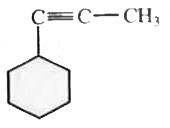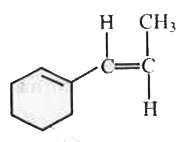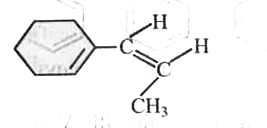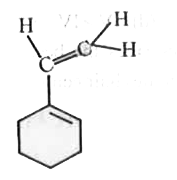Complete the following reactions :
(i) Isopropyl bromide→alc. KOH−−−−→HeatAHBr−−−−→PeroxideB
(ii) n-Propyl alcoholConc.H2O−−−−−−→443KAO2Ag−−→HeatB
(c) 1, 1, 2, 2-tetrachloroethane→Zn, alcohol−−−−−→HeatAIron tube−−−−→675KB
(iv) Acetylene→NaNH2−−−−→ACH3CH2Br−−−−−−→B
(v) Propyne→H2,Pd,BaSO4−−−−−−−−→QuinolineA(i)O3−−−−−−−→(ii)Zn,H2OB
Let's break down the reactions step by step:
(i) Isopropyl bromide to A and then to B
1. Starting Material: Isopropyl bromide (C3H7Br).
2. Reagent: Alcoholic KOH (alc. KOH) and heat.
3. Reaction: The alcoholic KOH will dehydrohalogenate isopropyl bromide, removing HBr and forming propene (C3H6).
- Product A: Propene (C3H6).
4. Next Step: Propene reacts with HBr in the presence of peroxide.
5. Mechanism: According to the anti-Markovnikov rule, HBr adds across the double bond of propene, resulting in the formation of isopropyl bromide (C3H7Br) where bromine adds to the less substituted carbon.
- Product B: Isopropyl bromide (C3H7Br).
(ii) n-Propyl alcohol to A and then to B
1. Starting Material: n-Propyl alcohol (C3H8O).
2. Reagent: Concentrated H2SO4 at 443K.
3. Reaction: Dehydration occurs, leading to the formation of propene (C3H6).
- Product A: Propene (C3H6).
4. Next Step: Propene reacts with O2 in the presence of silver (Ag) and heat.
5. Reaction: This leads to the formation of an epoxide through oxidation.
- Product B: Propylene oxide (C3H6O).
(iii) 1,1,2,2-tetrachloroethane to A and then to B
1. Starting Material: 1,1,2,2-tetrachloroethane (C2H2Cl4).
2. Reagent: Zinc in alcohol and heat.
3. Reaction: The zinc will reduce the tetrachloro compound, leading to the formation of ethyne (acetylene, C2H2).
- Product A: Ethyne (C2H2).
4. Next Step: Ethyne is heated in an iron tube at 675K.
5. Reaction: This leads to the formation of benzene (C6H6) through a coupling reaction.
- Product B: Benzene (C6H6).
(iv) Acetylene to A and then to B
1. Starting Material: Acetylene (C2H2).
2. Reagent: Sodium amide (NaNH2).
3. Reaction: NaNH2 will deprotonate acetylene, forming a sodium acetylide (C2H−).
- Product A: Sodium acetylide (C2H−Na+).
4. Next Step: Sodium acetylide reacts with ethyl bromide (C2H5Br).
5. Reaction: This leads to the formation of butyne (C4H6).
- Product B: Butyne (C4H6).
(v) Propyne to A and then to B
1. Starting Material: Propyne (C3H4).
2. Reagent: H2 in the presence of Pd/BaSO4 and quinoline.
3. Reaction: This reduces propyne to propene (C3H6).
- Product A: Propene (C3H6).
4. Next Step: Propene undergoes ozonolysis using O3 followed by reduction with Zn and H2O.
5. Reaction: This leads to the formation of acetaldehyde (C2H4O) and formaldehyde (CH2O).
- Product B: Acetaldehyde (C2H4O) and formaldehyde (CH2O).
Summary of Products:
- (i) A: Propene (C3H6), B: Isopropyl bromide (C3H7Br)
- (ii) A: Propene (C3H6), B: Propylene oxide (C3H6O)
- (iii) A: Ethyne (C2H2), B: Benzene (C6H6)
- (iv) A: Sodium acetylide (C2H−Na+), B: Butyne (C4H6)
- (v) A: Propene (C3H6), B: Acetaldehyde (C2H4O) and formaldehyde (CH2O)
1. Starting Material: Isopropyl bromide (C3H7Br).
2. Reagent: Alcoholic KOH (alc. KOH) and heat.
3. Reaction: The alcoholic KOH will dehydrohalogenate isopropyl bromide, removing HBr and forming propene (C3H6).
- Product A: Propene (C3H6).
4. Next Step: Propene reacts with HBr in the presence of peroxide.
5. Mechanism: According to the anti-Markovnikov rule, HBr adds across the double bond of propene, resulting in the formation of isopropyl bromide (C3H7Br) where bromine adds to the less substituted carbon.
- Product B: Isopropyl bromide (C3H7Br).
1. Starting Material: n-Propyl alcohol (C3H8O).
2. Reagent: Concentrated H2SO4 at 443K.
3. Reaction: Dehydration occurs, leading to the formation of propene (C3H6).
- Product A: Propene (C3H6).
4. Next Step: Propene reacts with O2 in the presence of silver (Ag) and heat.
5. Reaction: This leads to the formation of an epoxide through oxidation.
- Product B: Propylene oxide (C3H6O).
1. Starting Material: 1,1,2,2-tetrachloroethane (C2H2Cl4).
2. Reagent: Zinc in alcohol and heat.
3. Reaction: The zinc will reduce the tetrachloro compound, leading to the formation of ethyne (acetylene, C2H2).
- Product A: Ethyne (C2H2).
4. Next Step: Ethyne is heated in an iron tube at 675K.
5. Reaction: This leads to the formation of benzene (C6H6) through a coupling reaction.
- Product B: Benzene (C6H6).
1. Starting Material: Acetylene (C2H2).
2. Reagent: Sodium amide (NaNH2).
3. Reaction: NaNH2 will deprotonate acetylene, forming a sodium acetylide (C2H−).
- Product A: Sodium acetylide (C2H−Na+).
4. Next Step: Sodium acetylide reacts with ethyl bromide (C2H5Br).
5. Reaction: This leads to the formation of butyne (C4H6).
- Product B: Butyne (C4H6).
1. Starting Material: Propyne (C3H4).
2. Reagent: H2 in the presence of Pd/BaSO4 and quinoline.
3. Reaction: This reduces propyne to propene (C3H6).
- Product A: Propene (C3H6).
4. Next Step: Propene undergoes ozonolysis using O3 followed by reduction with Zn and H2O.
5. Reaction: This leads to the formation of acetaldehyde (C2H4O) and formaldehyde (CH2O).
- Product B: Acetaldehyde (C2H4O) and formaldehyde (CH2O).
- (i) A: Propene (C3H6), B: Isopropyl bromide (C3H7Br)
- (ii) A: Propene (C3H6), B: Propylene oxide (C3H6O)
- (iii) A: Ethyne (C2H2), B: Benzene (C6H6)
- (iv) A: Sodium acetylide (C2H−Na+), B: Butyne (C4H6)
- (v) A: Propene (C3H6), B: Acetaldehyde (C2H4O) and formaldehyde (CH2O)
Topper's Solved these Questions
- HYDROCARBONSBOOK - MODERN PUBLICATIONCHAPTER - HYDROCARBONSEXERCISE - PRACTICE PROBLEMS
34 Videos
- HYDROCARBONSBOOK - MODERN PUBLICATIONCHAPTER - HYDROCARBONSEXERCISE - Conceptual Questions
20 Videos
- HALOALKANES AND HALOARENESBOOK - MODERN PUBLICATIONCHAPTER - HALOALKANES AND HALOARENESEXERCISE - UNIT PRACTICE TEST
12 Videos
- HYDROGENBOOK - MODERN PUBLICATIONCHAPTER - HYDROGENEXERCISE - UNIT PRACTICE TEST (for Board Examination)
9 Videos
Similar Questions
Knowledge Check
CH3C∣BrHCH3alc./KOH−−−−−−→AHBr//peroxide−−−−−−−−→BCH3Na−−−−→C
In the above reaction sequence, the final product is:Adiethyl etherB1-methoxypropaneCIsopropyl alcoholDpropylene glycol
(i)NaNH2,NH3−−−−−−−−−−→(ii)CH3Br(A)H2−−−−−−−−−→Lindlar catalyst (B),A B
B C
C D
D
The following reaction is an example of
H−H∣βC∣H−H∣αC∣OHEthanol−HConc.H2SO4−−−−−−−→ΔCH2==EtheneCH2+H2OAoxidation reactionBreduction reactionCα- eliminaiton reactionDβ-elimination reaction
Complete the following reaction:
(i) CH3−C∣∣O−CH3CH3,MgBr−−−−−−→Dry etherAH+−−→H2OB
(ii) CH3−CH2−CH2−CHOH2/Ni−−−→A
View SolutionCH3−CH=CH2Br2−−→773K[A]KOH(alc.)−−−−−−−→Heat[B]
View SolutionComplete the following reactions sequence:
CH3−O∣∣C−CH3(i)CH3MgBr−−−−−−−−→(ii)H2O(A)Na metal−−−−−→Ether(B)CH3−Br−−−−−→(C)
View SolutionCH≡CHH2−−−−−−→Pd/BaSO4[A]Br2−−→[B]KOH(alc.)−−−−−−−→Heat[C]
View SolutionIn the reaction :
HC≡CHNaNH2−−−−→CH3I−−→YH2O,Hg2+−−−−−−→H+Z,
View Solution
